#Data cabling (TV points
Explore tagged Tumblr posts
Text
Bitz Electrical
Bitz electrical is a Melbourne-based Electrical and data communications company working in the residential and commercial sectors. We specialise in the maintenance, repair and installation of all things data and electrical. This includes but is not limited to; powerpoints, pendant lighting, downlights, dimmers, switches, outdoor and garden lighting, ceiling fans, security alarm systems, AV, CCTV, smoke alarms, TV points, phone points, data points and fibre optics, switchboard works, new builds, renovations and office fitouts. We pride ourselves on the high quality of our workmanship, punctuality, honest quoting and cleanliness.
Phone Number: 0452 395 663
Business Email: [email protected]
Website: https://www.bitzelectrical.com.au/
Facebook URL:https://www.facebook.com/profile.php?id=100083389294905
Instagram URL: https://www.instagram.com/bitzelectrical_pty_ltd/
Working Hours:
Mon - Thu - 07:00 AM - 05:00 PM Fri - Sat - 08:00 AM - 0:5:00 PM Sun - Closed
Address: Cheverton Rd, Lower Plenty VIC 3093, Australia

#Lighting(downlights#pendant lights#garden lighting#LED strip lighting#dimmers)#Power (Powerpoints#EV chargers#Electric Cooktops)#Ceiling Fans#Data cabling (TV points#Wireless Access Points#data outlets#fibre optics)#CCTV#Switchboard Works#Service & Maintenance#New Builds & Renovations#Commercial & Residential.
1 note
·
View note
Note
So I've been watching Oz, like you do, and reveling in the over the top everything about it, like you do, and on a whim I decided I wanted to look up where the slash-fandom-famous laundry room kiss scene falls in the timeline of early same gender kisses on television. Like you do. (I didn't think it was going to be taking home any prizes for first anything, but 1998 is still pretty early and notable for a bisexual protagonist ending up in a long-term relationship with another man.) However, I found to my surprise that there doesn't appear to be a comprehensive list of like, pre-twenty-first century gay American tv kisses anywhere.
Mostly what I've found have been extremely unrigorous listicles thrown together referencing whatever the writer happened to have imprinted on as a teen thirty years ago, and a huge amount of examples have slipped under the radar. I've also found that there's a lot of, maybe not misinformation per se, but inaccuracies reported as fact, the two most oft-repeated falsehoods being that LA Law aired the *first* same gender kiss on American television, and that Dawson's Creek had the first 'passionate' (non-jokey?) M/M kiss, neither of which are true. Also descriptions like 'passionate' are going to be entirely subjective anyway, although I do grant the point that what is meant is probably some combination of earnestly meant and non-stilted.
I'm compiling my own list in a haphazard kind of way, but research on this subject has been difficult to track down, because aside from LA Law, Dawson's Creek, and Buffy, there doesn't seem to be a great deal of cultural memory about the subject. Add to that the fact that many of the truly early examples are some combination of jokes, ratings stunts, or Very Special Episodes involving one-off characters, and you get into a certain degree of arguing about what really 'counts'. For me, I'm taking any and all comers, I just want some kind of list. I've also decided to exclusively focus on the US for now, because while Brazil, Germany, Australia, and the UK outstrip the US sometimes by a factor of decades, I'm most familiar with the television landscape and history of my own country, and it would be complicated enough researching other English-speaking countries, let alone countries whose languages I can't speak.
There's also some degree of back and forth in whether or how to count the Big Three/Four broadcast networks, first-run syndication, smaller broadcast networks, and cable channels. The upshot being, Oz (among others) I've found has largely been left off of lists like these because it was on HBO and not a broadcast network (when it's not just being collectively memory-holed out of the public consciousness). But I think that there's a pretty significant point to be made about the comparative conservatism of the major networks, beholden as they always have been to ad revenue, versus cable channels getting away with myriad examples of 'edgier' content because they've always been subscriber based. That is an analytical point of data in itself, imo.
So I'm turning the mic over to the rest of you, and asking for recommendations for where to even start. I've got a spreadsheet of something like thirty of the easier-to-research examples, but I was hoping someone might know of a preexisting comprehensive list, or at least suggestions of some perhaps less obvious examples. (Xena sure does have a LOT of women kissing!) I've decided I'm going to focus exclusively on the twentieth century for now, and go up through the year 2000, but not beyond (sorry Buffistas). Is that in part because the US adaptation of Queer as Folk premiered in December of that year, and it fundamentally altered the landscape of gay American television, and trying to count gay kisses on QaF is like trying to count grains of sand on a beach? You can't prove it, and also I never said I was particularly rigorous either. Average early 2000s American television show featured three gay kisses per year factoid incorrect. Spiders Brian, who lives in a cave in Pittsburg and kisses three men each day, is an outlier adn should not have been counted.
Anyway, thanks in advance for any advice or suggestions!
--
Well, if we're counting very special episodes and ratings stunts, DS9's f/f kiss got a lot of attention.
I wonder if Matt Baume would know of a list.
33 notes
·
View notes
Note
Since you’re in casting, I’d love to pick your brain a little about selecting actors. I love that Jared is a constantly rising star, but in the most loving way possible, he really isn’t the best actor. 80% of the time when I’m watching him, it feels like I’m watching someone acting. He’s not the most natural Versus someone whose performance I get lost in. That doesn’t mean I’m not going to watch everything he does, and it kind of seems standard for cable network TV (for example, I feel the same ways about Nathan Fillion, David Boreanaz, Matthew Daddario - but it doesn’t make me like them any less). Honestly, the only network TV show they didn’t make me feel that was is Hannibal, and even that was only the leading actors.
I would have assumed that acting ability would be the most important part, but your page has made me realize it’s more than that, and let’s be honest, Vampire Diaries wouldn’t haven’t gotten that far if acting was the most important skill set needed. I’m guessing for the Jared’s and David’s their entire history counts most, but what about for someone just getting hired - the Jared getting the Gilmore Girl’s role or the David getting the Angel role. If they’re acting seems…stiff (wrong word?) what makes a casting director say, ‘you know what, let’s give it to them anyway.’
It’s just such a hard world to break into and I’m guessing there are auditions from people with a little more natural talent, so what makes that final decision?
(Asking as someone who is about to start the audition process)
I think what Jared (and Nathan, David, etc) has doing for him is he acts from his authentic truth. I'll expand on it later in this post. With that said, Jared is a character actor trapped in a leading man role, it's why he's not the "best actor" because people tend to believe that good character actors disappear into their roles by diminishing their screen presence, which you can't do when you're a leading man. You may be picking up on this conflicting issue. Think of Brad Pitt who works best as a supporting actor (X), and struggles a bit as a leading man so he has to throw out nuances and reply more on his raw charisma.
I haven't seen Gilmore Girls but I read Jared was the 2nd or 3rd Dean. Dean was recast because the OG Deans' chemistry with Rory wasn't up to snuff. So that answer your "final decision" question, which is chemistry. David Boreanaz had good chemistry with Sarah Michelle Geller. His chemistry Emily Deschanel in Bones was fine, bordering on good, but it was more fun/odd couple vibe whereas his interaction with Michelle had depth. Whenever Jared and Jensen tell their chemistry audition story in front of the producers, I'm pretty sure they're leaving out that Jared likely had chemistry auditions with other various Dean actors.
My advice on auditions is walk into that room like you’re going to solve their problem.
Most casting directors talk about wanting auditioning actors to "make bold choices" because they believe it will get in touch with their authentic self and therefore, make them a captivating performer. My advice is adjust the text to your authentic emotion so that you're reacting to the events of the story from your internal truth. It doesn’t matter if the story is a sci-fi, comedy, or a period piece drama: if we don’t believe the actors, we won’t care what happens to them in the story. The audience is an incredible lie-detector: the average person has, for their entire life, been storing countless passive data on how normal people react to various situations, so you can’t fool them.
My CD used to say that it's easier to tell the truth on camera than it is to lie because once you believe in yourself, then you're not acting anymore. I don't 100% agree with her but that seems to be what most CDs think.
The more confidently you use yourself as a canvas and let the context of the scene speak through your own emotional repertoire and point of view, the more compelling and interesting you are to watch. The most interesting or captivating actor is the one whose next movement, facial expression, or line reading is unpredictable. That's the difference between Jeff Bridges (unpredictable) and Beu Bridges (reliable).
27 notes
·
View notes
Text
Dan Pfeiffer at The Message Box:
Even in a media environment where consumers have unlimited choices, a 60 Minutes interview is the coup de grace. A campaign would do almost anything to be featured. The highly-rated program comes on right after NFL football — making it the one thing on broadcast TV that still draws a mass audience. Donald Trump pulled out of the 60 Minutes interview, ceding the entire show to his opponent. In the campaign's final weeks, Trump also reportedly pulled out of interviews with CNBC and NBC News. He turned down an opportunity to participate in a prime-time CNN town hall. In fact, Trump didn’t do a single interview with a traditional news outlet in the campaign's final stretch. No national broadcast interviews, no sit-downs with local TV anchors or newspapers.
The winning candidate ignored the traditional media, focusing instead on partisan media outlets and politics-adjacent podcasts. While this change isn’t new, it seems clear that 2024 was a pivot point for the role of the legacy media in politics. Democratic communications strategies have evolved over the years — and the Harris campaign did some very innovative things. Nevertheless, our approach to communicating with voters continues to depend heavily on the legacy media. When we have something to say, we look for a cable or broadcast network to say it on. We spend an inordinate amount of time thinking about the morning tipsheets and which surrogates are booked on cable news. New York Times headlines can be a party-wide obsession. Do Democrats need to follow Trump’s lead and break up with the legacy media? The Right Wing media’s advantage was particularly decisive during this election. This is the first in a series of posts discussing how Trump outmessaged us in the 2024 election and what we can do in the future.
A Changed Dynamic
For a long time, the political press was the most powerful force in politics. So powerful that they were known as the “Fourth Estate” with the capacity to make or break a campaign. The list of failed presidential candidates who were unable to win over the tastemakers in the media is long. One can credibly argue that unfair press coverage from the New York Times and others were a significant factor in Hillary Clinton’s 2016 loss.
The traditional media has been losing relevance for a while now. The death spiral of the political media is a much longer, more complicated story (I wrote a lot about it in my most recent book), but there have been a few dynamics driving this descent. The first is the rapid pace of technological innovation. Newspapers were once the most powerful entities in media. A presidential campaign wanted nothing more than a great picture on the front page of the Des Moines Register, Philadelphia Inquirer, or Detroit Free Press. Most local papers are shells of themselves — simply carrion for private equity to drain the last few cents before closing up shop. While the New York Times and Wall Street Journal are thriving, the Washington Post is bleeding money and full of controversy, and USA Today barely registers (I had to Google if it was still published). Cable and broadcast viewership is down as more consumers cut the cord or turn to social media for news. Legacy media is simply reaching fewer people. Second, the media reaches people who are less likely to believe what they read/see/hear.
[...] A Data for Progress poll found that Kamala Harris won voters who consumed “a great deal” and “a lot” of news but lost the voters who consumed no news by a whopping 19 points.
The New New Media
The biggest media events of the 2024 campaign were not on 60 Minutes or Meet the Press. They didn’t involve the New York Times or any of the major cable channels. They were interviews with podcasters Joe Rogan and Alex Cooper. The media titans are influencers with large followings and parasocial relationships with their audiences. Many voters no longer trust media institutions, but instead trust folks with whom they often spend hours every week. A Pew Knight study found that one-in-five Americans – 37% of adults under 30 – regularly get their news from social media influencers. Trump and the Republicans have better understood this shift than Democrats. At the end of the campaign, nearly all of Trump’s media interactions were with Right-leaning podcasters commanding massive social media followings. During Trump’s victory speech, UFC boss Dana White came on stage and specifically thanked Adin Ross, the NELK Boys, Theo Von, and the folks from Barstool Sports. The GOP has actively tried to support their influencers with interviews and attention. While Kamala Harris did appear on Cooper’s wildly popular Call Her Daddy podcast, most Democrats kept podcasters and news influencers at arms length.
Dan Pfeiffer’s latest Message Box Substack post shows that the Democratic Party’s overreliance on legacy media at the expense of nontraditional media came back to bite them, and that Dems should focus more on nontraditional media outlets in addition to the legacy MSM.
#Democratic Party#Mainstream Media#Media Bias#Donald Trump#Kamala Harris#2024 Presidential Election#2024 Elections#Media Consumption#Data For Progress
9 notes
·
View notes
Text
The Federal Communications Commission has voted—once again—to assert its power to oversee and regulate the activities of the broadband industry in the United States. In a 3-2 vote, the agency reinstated net neutrality rules that had been abandoned during the height of the Trump administration’s deregulatory blitz.
“Broadband is now an essential service,” FCC chair Jessica Rosenworcel said Thursday in prepared remarks. “Essential services—the ones we count on in every aspect of modern life—have some basic oversight.”
The rules approved by the agency on Thursday will reclassify broadband services in the United States once more as “common carriers” under Title II of the Telecommunications Act, subjecting broadband to the same public-utilities-style scrutiny as telephone networks and cable TV.
That distinction means that the agency can prevent internet service providers from blocking or throttling legal content, or letting online services pay ISPs to prioritize their content with faster delivery speeds. But it’s difficult, particularly in an election year, to say whether net neutrality is here to stay or whether the FCC’s vote is just another inflection point in a regulatory forever-war.
“Net neutrality rules protect internet openness by prohibiting broadband providers from playing favorites with internet traffic,” Rosenworcel says. “We need broadband to reach 100 percent of us—and we need it fast, open, and fair.”
This reclassification was first attempted by the Obama administration following a lawsuit by Verizon in 2011; the ruling pointed to reclassification as a necessary hurdle in efforts to bring broadband under scope of the FCC’s oversight. The outcome of that case prompted the introduction of the Open Internet Order of 2015, which not only reclassified the industry in line with the court’s suggestion but imposed a slate of new rules with “net neutrality” serving as the FCC’s guiding philosophy.
Two years later, those rules were overturned by the Trump-appointed FCC chair at the time, Ajit Pai, a former Verizon lawyer. Back in the private sector now, Pai derided the FCC’s efforts this week as a “complete waste of time;” something, he said, “nobody actually cares about.”
The rules put forth under Rosenworcel are somewhat different than those previously introduced. Past FCC orders pursing net neutrality have been repeatedly challenged in court, giving the agency today a fair idea of which policies will be defensible in the onslaught of lawsuits definitely to come.
Though banning the creation of “pay-to-play internet fast lanes” remains a priority, the reasons for reclassifying broadband are not limited to warding off the industry’s well-documented predatory practices. The new order also gives the FCC the ability to more closely examine industry behavior; how, for instance, companies respond (or fail to) in the event of widespread network outages.
“Net neutrality” was not originally devised as a set of rules but rather as a principle by which regulators seek to strike a balance between the profit-motivated interests of megalithic broadband companies and the rights and welfare of consumers. It is often summed up simply as the practice of ensuring that “all internet, regardless of its source, must be treated the same.”
While the Trump FCC asserted that it had no authority to regulate ISPs, it paradoxically claimed—in a failed effort—the power to crack down on states working to create regulation for themselves. Still, in 2018 California successfully banned broadband companies from engaging in a host of anti-consumer activities, from digital redlining and data discrimination to zero-rating schemes, which enable ISPs to funnel consumers toward particular websites or services by exempting them from arbitrary data caps.
Net neutrality advocates typically credit laws like California’s with preventing “virtually lawless” service providers from going haywire over the past half-decade. Industry associations offer a counter-history: Net neutrality protections must have been pointless all along, since the sky didn’t fall once they disappeared.
State-level protections, however, haven’t prevented cable and satellite TV companies from pushing a menu of anti-consumer policies nationally. The industry has threatened to hike monthly subscription prices if ever prevented from charging early-termination fees to customers locked into yearlong contracts. It has opposed rules proposed by the Federal Trade Commission designed to “make it at least as easy to cancel a subscription as it was to start it.”
Rosenworcel and other net neutrality proponents point to the growing reliance on broadband as successive generations of Americans increasingly eschew forms of communication that traditionally fell under the FCC’s blanket. Broadband is undeniably a telecommunications service today—even more so now than when the FCC first sought to adopt net neutrality as its guiding principle.
“Today's action brings back moderate rules that have already passed court muster and are essential building blocks for a consumer-friendly and citizen-friendly internet,” says Michael Copps, a former FCC commissioner. “Our communications technologies are evolving so swiftly, affecting so many important aspects of our individual lives, that they must be available to all of us on a nondiscriminatory basis.”
Consumer reliance on digital platforms and tools for communication is only increasing: Teenagers today notoriously loathe—some say fear!—talking on the phone, while the landscape of communications dynamics shifted violently for US workers in the post-pandemic era. Nevertheless, Americans today have little agency on their own to combat predatory-pricing schemes and lopsided usage restrictions. Consumer advocates note that Americans cannot simply vote with their wallets while locked into receiving services from a de facto monopoly.
While having evolved far past its original conceit, net neutrality is at heart a policy of "non-discrimination," as Tim Wu explained in the 2002 white paper coining the phrase.
“The point of the neutrality principle is not to interfere with the administration of the internet-protocol side of a broadband carrier’s network,” wrote Wu, then an associate professor at the University of Virginia Law School. “It is, rather, to prevent discrimination in that administration.”
15 notes
·
View notes
Text
yasper is dying a slow death because the wifi in his building is isn't working. he can't even get a good hotspot running because the cable company is throttling his bandwith for using more data than 99.5% of all customers. aniq tells him he should file a complaint with the fcc.
yasper is playing minesweeper at lightning speed while his internet is down. each time he accidentally hits a mine, he screams in distress. aniq can now tell yasper's minesweeper screams from his normal screams. yasper kind of misses the way aniq would run in all concerned the first few times before he wised up. the red timer in the corner of the screen counts the seconds. in his haste to beat his last record, yasper mis-clicks on a mine. he quickly hits control + z; it's not cheating if he meant to click on the square to the left.
yasper is so bored that he actually files a complaint with the fcc. the guy on the phone keeps asking him pointed questions about his internet contract. yasper's getting to that, but he has to set the scene first! it was a lazy summer afternoon, with the kind of perfect weather that was made for sitting inside and watching youtube. olivia rodrigo's new album had just come out and it was time to crank that shit up to 1080p on the tv...
yasper is sitting on a park bench with aniq, eating a turkey sandwich and surveying a flock of pigeons. aniq inexplicably loves pigeons but yasper finds them deeply sinister. as a peace offering, he tosses a crumb from his sandwich onto the ground. the pigeons swarm the crumb, cooing and fluttering. yasper grimaces, feeling menaced. pigeons are so awful, he says to aniq, you have terrible taste. yasper realizes that this was technically a self-burn, but aniq just gives him a lovestruck smile.
yasper is pulling into the mcdonalds drive through and getting hassled by chelsea about almost hitting the curb. with an accusatory point, she asks, how come you're only a good driver when aniq is in the car? yasper is trying and failing to come up with an explanation that doesn't involve the phrase precious cargo. instead, he rolls down his window and orders two mcflurries and a large fries.
7 notes
·
View notes
Text
The Future of Television: an Introspection
I think we are at a transition point

This story begins in the Los Angeles airport, LAX. Earlier that day, I had a flight scheduled to fly from Burbank to Cincinnati (with a layover in Atlanta) to visit my parents. The flight, unfortunately, was delayed due to weather conditions, so the airline booked me for a or straight flight to CVG. After making my way over to LAX, I noticed the TV near a bar near where I was sitting- and something caught my eye.
An advertisement: for Disney+, Hulu, and Max for $17 with ads, and $30 with ads.
First of all, that's too inexpensive. With previous cable packages exceeding $100 a month, having 3 of the largest and most well known streaming services together in a single deal for less than a third of that previous price is simply unsustainable. My guess – is this deal is introductory pricing to get people used to this bundle as a norm, after which the price can slowly increase without much customer loss.
Secondly, why? Disney and Hulu makes sense, Disney owns Hulu, but Max? Max is owned by WarnerBros. Discovery, one of the largest companies in the video streaming space, and Max itself is a direct competitor to Disney+. What would they have to benefit from cooperation?
Here’s what they have to benefit:
Firstly - some business terms
A knock on the door is heard. Claire opens the door. BYSTANDER enters looking confused. Bystander: I thought this essay was about television? Claire: You thought making television was about making television? Bystander shrugs. Claire: Unfortunately... it's about the money >:3

Economies of scale is an economic principle indicating that the more you produce of something, the less it costs per item to produce. If I want to make 1 copy of The Glass Scientists by Sage Cotugno (a very good graphic novel you should read ( ᵔ ⩊ ᵔ )), it might take me 5-10 hours to print out the pages, bind them together, cut out the cover, glue the whole thing, etc.
If the cost of the materials is, let’s say, $7.00, but it takes 7 hours to make (at $25 an hour, because I’m an expensive bitch (¬‿¬ )) - then it costs this hypothetical company $182 to make this one book. That means you as a consumer would be charged around $200 - very expensive (>﹏<).
On the other hand, if I want to make 10,000 copies of this book, and I have $100,000 dollars lying around (as one does), I can buy an industrial book printing machine for $30,000, and even with 30 hours of labor, it still costs:
Labor - 30 hours of work * $25/hr = $750 Materials - $7 per book * 10,000 books = $70,000 Cost of Equipment - $30,000 Total Cost - $100,750 Cost per book - $100,750 / 10,000 books = $10.075
about $10 per book, which, in terms of individual cost, is a huge difference from our first estimate of $182.
Now, to be frank, these numbers are all bogus. I have no idea how much it costs to make a book - but the principle is the same with real numbers.
When your production scales up, your cost per product goes down. Massive corporations don’t build megafactories because they like the aesthetic: they do it because it saves them money.

Now, this makes sense for physical products like books, but it also applies to intangible goods, like software, or web design, or streaming technology infrastructure (ding ding ding).
From a business standpoint it doesn’t make sense for 6 different companies to develop 6 different compression algorithms, and have 6 different interfaces to connect to 6 different data centers to do exactly the same thing: take an uncompressed ISO file, compress it for streaming, and send it to your device.
I personally think this is why we are seeing a lot of corporate consolidation in our current era of streaming – because, from a distributor perspective, it makes sense for all companies in the space to work together - or at least consolidate into a much smaller number of players.
But that’s only one-half of the story:
Seeing these companies merge and bundle was not what originally got me thinking about this whole, media market structure thing.
What got my gears turning was something a lot closer to what I actually care about.
Over the past couple of years, it’s been very disheartening to see many wonderful and amazing series get cut short for seemingly no reason.
I love Inside Job. Shion Takeuchi’s sense of comedy, combined with the fondness and criticalness the show has for Reagan makes her growth feel so authentic! I love seeing what she's doing, when she is in over her head, figuring out what she wants out of life. It’s amazing and funny and incredible.
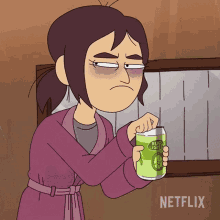
I love Scavenger’s Reign! Joseph Bennett and Charles Huettner and everyone on the crew do such an amazing job at crafting this eerie fascination for biology. I can totally see the show, and Joseph Bennett’s narrative style, becoming seminal in science fiction later on. Amazing work.
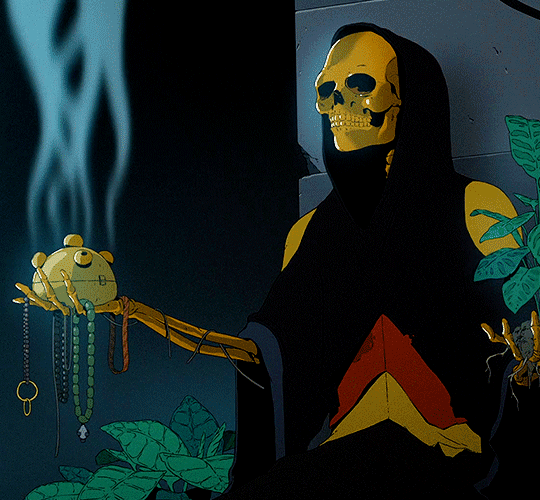
The Owl House! An amazing Disney show created by an amazing person loved dearly by many amazing people. (you can also replace the word amazing with the word gay and it still works! (o^ ^o))
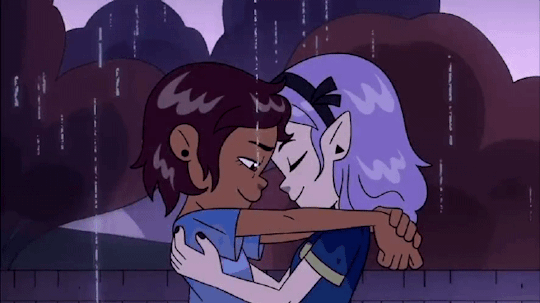
Inside Job wasn't renewed for a season 2 by Netflix. Owl House had its season 3 cut short. Scavenger’s Reign wasn’t renewed by Warner Bros. Discovery, was brought over to Netflix, and then was canceled by Netflix!
To be honest, I don’t know everything about television production. I want to learn and I want to discover but at this point in time I don’t have a clear answer of why these shows were canceled.
Dana Terrace has stated that The Owl House was canceled without her input, which is incredibly disheartening to hear.
Netflix hasn’t made an official statement about the reasons for Inside Job being canceled or Scavenger’s Reign - but I have a theory about what’s going on
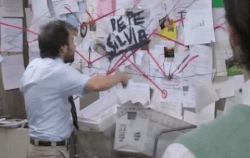
Remember when I mentioned economies of scale? Well, there’s an inverse economic principle called diseconomies of scale. Diseconomies of scale indicates that at a certain scale, as production gets larger, the cost per item gets more expensive, rather than less expensive. This can be due to a whole basket of factors, from increasing organizational costs, to transportation and distribution costs, etc. It’s the reason why there isn’t 1 factory that makes all the paper towels in the world. If economies of scale were an absolute rule, that single factory would be the standard, but it’s not. There are certain economic advantages to having multiple smaller factories rather than 1 giant factory (transportation, distribution, etc.).
There are economic reasons for a company to scale up production, but there are also economic reasons for a company to scale down or split production. When companies are at an equilibrium between economies of scale and diseconomies of scale, they are operating at their maximum market efficiency.
So, how does this apply to streaming companies?
Well, I mentioned before my theory that streaming companies are consolidating due to economies of scale from a distributor perspective, but these companies aren’t just acting as content distributors, they’re also acting as content producers.
Ye Old Media Wisdom Having a single company as a distributor and a producer is a bad idea. -me just now :)
Here’s why:
One of the aspects of diseconomies of scale is the problems with large organization. As a company gets larger, it becomes more and more difficult for people to communicate up and down the ladder and to communicate with different departments across the company. If your company is making something easily measured, like paper towels, your company can be both large and successful (like P&G) because the measurements of what makes a paper towel valuable for the consumer and for the company are easily communicated between teams. If a team is able to make a paper towel 10% more absorbent with a 2% increase in weight, it’s easy to communicate that possible change to a higher up - and their decision, whether to proceed with that change or not, will be made with most of the important details needed for that decision, primarily because those details are easy to communicate.
Making entertainment, especially animated entertainment, is something that is much more complex, subjective, and harder to communicate than paper towels. Different series appeal to different people, different shows have different voices, and being able to communicate the benefits of a series to a friend is challenging, let alone an executive 3 organization levels up. Additionally, making an impactful and amazing series takes risks! All great storytelling is communicating a perspective that is unique and engaging, but to make something unique is by definition to make something new, which requires risk. Larger companies are more risk averse than smaller companies: they have more to lose, are harder to change, and adapt less quickly. For a company whose primary purpose is to make stories that people engage with, being larger is, unfortunately, antithetical to that goal. People who want to make something different deal with more red tape, more bureaucracy, and more people their story has to please. It becomes harder and harder to make something that is new and impactful - to put it another way, it becomes harder to make something successful.
In my opinion, many of the recent releases of Disney feel… generic. Lightyear, Strange World, Wish - these films are by no means made by people without skill or character, but if those people are not allowed to take risks, if they’re not allowed to make anything outside the lowest common denominator of opinions, then the perspective these films convey is destined to be bland and uninteresting.
In my opinion, this is why companies like Riot / Fortiche and Sony Pictures Animation have been kicking ass recently. Spider-Verse, Mitchells and Arcane are amazing and seem to have the support and space they need. Since Riot and Sony Pictures Animation aren’t distributors, they don’t have the same pressure to become a larger company themselves. They can stay the size they want and continue to produce animation at a quality and risk level they are comfortable with.
I don’t know exactly what’s going on inside these companies, there might be other factors that contribute to their success - but I do know that making TV is hard. Making anything at a studio level is hard. Many people have to spend months of their lives working, communicating, and trying to discover what this thing they’re working on is. When people working on these series not only make something, but make something incredible - and after all that, are not be supported?
well, that’s just bad business

Epilogue
So where do we go from here?
Well if I were in charge of the largest media corporations on the planet, I’d say: spin off your animation production companies into their own entities and act, primarily, as the best distributor on the market. This will allow for you to remain as the larger corporate entity you want to be but remove the bureaucratic restrictions on production companies. Additionally, it gives the distributor more choices! Now they don’t only stream your own content, they can stream anyone else’s if they want! If another, better player comes into town, making more popular media, they can stream their shows instead. Production companies get the freedom to make great things, distributors get the structure and size that they need, and consumers, because of the competition between the two, get the best deal for their money.
This is what cable TV was in my opinion: one or 2 big distributors offering the same service, and many smaller production companies making the things we love.
Ideal market structure for media distributors, I think, is 1 or 2 big companies.
Ideal market structure for media producers, however, is many smaller companies.
It will take time, but I think we’ll get to this market structure eventually – or something new might come along, who can say (ᵔ ⩊ ᵔ)
In the meantime, I wish a tremendous amount of support to the artists and individuals who make the animation and series that we all love.
Y’all are why any of this exists in the first place – don’t forget that.

-Claire
4 notes
·
View notes
Text
How Can Wear Communications Improve Your Connectivity in Surrey?
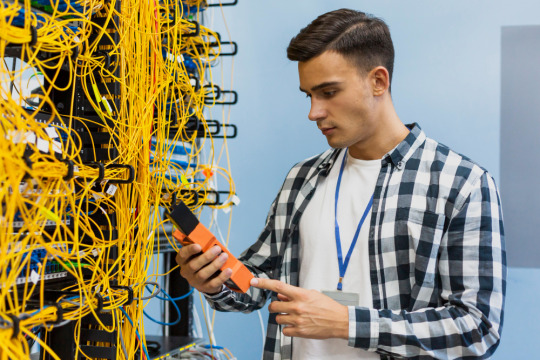
Whether you're upgrading a home network, building out commercial infrastructure, or setting up a reliable TV system, the quality of your installation makes all the difference. In Surrey, where everything from rural homes to corporate offices demand high-speed, stable connections, Wear Communications stands out as a trusted provider of professional WiFi installation, satellite installation, aerial installation, and network data cabling services.
With decades of technical experience and a strong focus on reliable performance, the team delivers future-ready solutions to properties across Surrey. Here’s how their services ensure better connectivity and lasting value.
WiFi Installation Surrey – Eliminate Blackspots and Boost Performance
Slow internet and patchy signals are more than just inconvenient—they disrupt daily life and work productivity. Wear Communications provides expert WiFi installation in Surrey, customised to suit the size, structure, and layout of each property.
Their engineers don’t just plug in a router—they analyse the building’s architecture, assess interference levels, and install systems that maximise both coverage and speed. Using high-quality mesh networks, business-grade access points, and secure configurations, they ensure every room gets reliable WiFi.
Ideal for:
Home offices and remote work
Multi-device households
Online gaming and streaming
Small to medium businesses
Whether it’s a top-floor flat in Woking or a detached property in Epsom, Wear Communications brings consistent internet performance throughout your space.
Satellite Installation Surrey – Accurate Setup for Stronger Signals
Modern entertainment depends on more than just smart TVs—it requires properly installed satellite systems that deliver uninterrupted viewing. With Wear Communications' expert satellite installation in Surrey, you can expect professionally aligned dishes, robust signal strength, and discreet installation that suits the look of your home or office.
The team supports:
Sky, Freesat, and international systems
New dish installations and system upgrades
Repositioning, alignment, and fault correction
Multi-room connectivity for households or shared buildings
They work efficiently while respecting your property—minimising disruption while delivering flawless satellite reception.
Aerial Installation Surrey – Crisp Reception for Every Screen
Still relying on Freeview or digital aerial services? You’re not alone. Thousands of Surrey residents watch TV through aerial connections. However, poor installation or outdated equipment can cause interference, weak signals, or full loss of service.
That’s where Wear Communications steps in, offering top-tier aerial installation in Surrey tailored to your environment. From new builds to heritage properties, they ensure your signal is strong and stable—regardless of location or building type.
Their aerial installation services cover:
Digital TV aerial systems
DAB and FM radio aerials
Signal testing and fine-tuning
Aerial upgrades, repositioning, and fault repairs
Every job includes a full assessment to ensure the aerial works in harmony with the surrounding signal landscape, avoiding tall trees, obstructions, or reflective materials that can affect performance.
Network Data Cabling Surrey – Smart Wiring for the Digital Age
WiFi has its place, but when you need speed, stability, and security, nothing beats structured cabling. Businesses, landlords, and homeowners alike turn to Wear Communications for dependable network data cabling in Surrey that supports high-bandwidth applications, security systems, and smart building setups.
Their data cabling solutions include:
CAT5e, CAT6, and CAT7 installations
Structured cabling design and layout
Ethernet point installations for homes and offices
Fibre optic cabling for ultra-fast connections
Patch panels and server rack configuration
Every cable is routed cleanly and tested before sign-off, ensuring the network is ready to support remote working, VoIP, CCTV, or any other data-heavy setup.
Tailored Solutions for Residential and Commercial Clients
What makes Wear Communications different is their ability to handle both residential and commercial projects with equal care and precision. Whether you're a homeowner in need of a new aerial, or a facilities manager overseeing a data cabling rollout in a multi-storey office, their team delivers scalable solutions with a personal touch.
Clients include:
Homeowners improving their entertainment systems
Builders needing installation across multiple plots
Landlords ensuring strong signal across rental units
Offices upgrading to modern, high-speed networks
Retail stores requiring strong WiFi for POS and CCTV
Every job is handled by trained engineers who understand the specific connectivity demands of each environment.
More Than Installation: Ongoing Support You Can Count On
Connectivity isn’t just about getting things set up—it’s about making sure it keeps working long-term. Wear Communications offers more than just installation; they also provide diagnostics, upgrades, maintenance, and system health checks to ensure your setup continues to deliver.
This is especially important in larger homes, older buildings, or environments with changing tech demands. As smart homes and connected offices become the norm, your system should grow with you.
They also offer advice on:
Device compatibility
Equipment positioning
Network security
Future-proofing with cabling and hardware
This consultative approach ensures you're not just connected today—but prepared for tomorrow.
Get Connected with Confidence – Choose Wear Communications
If you're looking for:
Professional WiFi installation in Surrey
Accurate and secure satellite installation in Surrey
Durable and discreet aerial installation in Surrey
Future-ready network data cabling in Surrey
Wear Communications offers everything you need under one roof.
Whether you're planning a new setup, fixing ongoing issues, or upgrading for better performance, their team is ready to help. With years of experience, a strong reputation in Surrey, and a customer-first mindset, they’re the go-to choice for communication system installations across the region.Contact Wear Communications today to book a site visit or speak with a qualified engineer about your property’s connectivity needs.
#WiFi installation surrey#satellite installation surrey#aerial installation surrey#network data cabling surrey#wear communications
1 note
·
View note
Text
Electrician Joondalup

At EcoPower and Communications, we are a team of fully licensed electricians (EC12085 and SA59141) who offer a wide range of electrical, security and communications solutions to Clarkson & the surrounding areas. Company owner, Jason, has years of experience in the industry; providing installations, repairs, and maintenance services for residential, commercial, and industrial properties. Our security solutions include CCTV cameras and security lighting. We also offer communications solutions such as phone, data cabling, Intercoms, TV points and antenna signal testing and installation and can also assist with Theatre works which include TV mounting, HDMI and optical solutions along with speaker wire and installation. For WA Seniors Card holders, government rebates are also available for work done on security lighting, CCTV, RCD Safety Switches and smoke alarms. We ensure every single customer receives a high-quality job and brilliant customer service, just see our 5-star reviews!
Electrician Joondalup
Click Here
2 notes
·
View notes
Text
a fun fact about me is that our house didn't have a PC until i was about 14 -- and even then, it was shared by the whole family, and didn't have internet access for a while. my dad eventually signed up for AOL around 2001, at which point we were able to surf the web™ via a 56k dial-up connection.
however, we did have internet access prior to that… via our TV:

source: https://web.archive.org/web/20190407175637/https://www.digitalspy.com/tech/cable/a3171/ntl-cr2-interactive/
this gave us a (single, shared) email address, and access to an extremely limited number of websites, such as leisuredistrict or everyoneswelcome.
(as an aside: you could unlock "full" web access by paying an extra £5 per month, which we eventually did… but not before discovering that if someone emailed us a clickable link, we could access that site without going through the "proper" menu option!)
anyway, to compose emails, enter your leisuredistrict password, or write an everyoneswelcome post, you had to use the remote control:
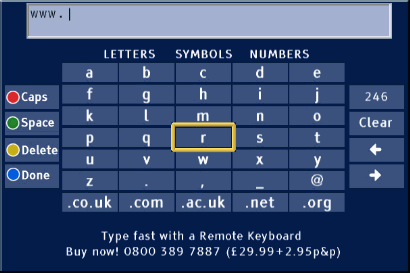
source: https://web.archive.org/web/20190407173228/https://www.digitalspy.com/tech/cable/a3231/ntlhome-digital-interactive-tv/
as you can imagine this was slow and awkward. however, as the image above indicates, you could buy a special keyboard to make things easier. since my dad used to play chess via email (using a physical chess set next to the television), he ended up getting one:
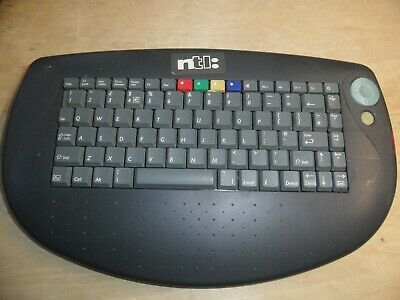
source: https://www.reddit.com/r/nostalgia/comments/hm5pfa/these_ntl_keyboards_i_think_im_on_an_ntl/
as you might have noticed, it has a somewhat strange layout, and doesn't have a wire coming out of the back. that's because this keyboard is actually just a really big remote control; you put 4 AA batteries in the back, and it communicates with the set top box via infrared signals, just like the standard remote control would.
of course, our set top box eventually outlived its usefulness, and all of this stuff went into a storage cupboard, whereupon it was promptly forgotten about… until a few months ago, when i rediscovered the keyboard whilst my dad was clearing out some old things. as you might expect, i saved it from being sent to silicon heaven (where all the calculators go) because i am a goblin who hoards old technology.
i put it to one side for a while, but a few days ago i decided to see if it was still working. it turns out that regular webcams can pick up infrared light, so i put some batteries in it and -- success! -- several white-ish lights were visible in my laptop's webcam app whenever i pressed a key.
as such, i think it would be cool to somehow get this thing working as an actual PC keyboard. i might need to write a custom program to do this, though it seems that it might Just Work.
of course, i'd need some kind of infrared receiver device to do that, and those can be surprisingly tricky to find:
there are plenty of "infrared extender" cables online, but their USB connector is only used to draw power; they don't actually show up as a "device" on your PC.
you can apparently get infrared-receiver-to-headphone jack cables, which you're supposed to plug into a special socket on certain set top boxes… though in theory you could plug them into the microphone input port of a PC and "manually" decode the data signal via software trickery. (disclaimer: i am not an expert on Hardware, so this might be A Bad Idea, but i think that the 5V output by the microphone port would be enough to power the IR receiver…?)
the thing i actually want (an IR-to-USB device) might as well not exist because it is no longer 2005 and no-one on the planet except me gives even half a shit about connecting an IR device to a PC. well, that's not entirely true -- but the things i did find cost £30-£50, which is way above what i'd want to spend on something like this.
eventually, though, i discovered that the magic phrase to search for is "Media Center IR receiver" (or, more simply, "MCE receiver"), whereupon i found someone selling an Acer MCEIR-210 on ebay for just over £10. its due to arrive here within the next few days, so hopefully i can make this somewhat-unusual device function again.
#infrared#old tech#keyboard#old web#please read this post like its a Cathode Ray Dude video for maximum effect
9 notes
·
View notes
Text
So. I have
Unicron, a large and spacious desktop with an ancient motherboard and aging i/o that works
Primus, a tight server-adjacent beast of an air purifier the computer shop gave me for free cause it doesn't work
My sata power adapter finally came in the mail. It's not doing anything. I believe it's possible to get Primus working, i really do. But probably not by me.
Now here's the other part of the problem:
Unicron is currently hosting all my files and i want it to also drive the 4k tv. It's running Linux of course. The graphics card is from before AMD bought ATI, the only way I can get video from it is a DVI-to-VGA adapter plugged DIRECTLY into a VGA cable going DIRECTLY into a 1080p monitor. Adapting to hdmi doesn't work, even tho the active adapter itself definitely does. The only graphics cards in town that go in old school PCI slots are worse than mine, and the pci-to-pcie adapters I'm seeing online look sketchy af. (are they? If you've used them please tell me if they work). I spent $200 on an rx6600 and at this point I'm almost ready to build a whole pc around it, just to have something with room to grow. Also transcoding maybe.
Now, I have several usb-C to hdmi adapters which require windows drivers. Unicron does not have usb-C ports. Unicron barely has USB 3 ports. I have exactly one (1) USB A to C high speed data adapter of the proper sexuality - which came with and is currently in use for the nvme enclosure I'm using for my cache drive. Because, to loop back around, Unicron doesn't have anywhere else to put an nvme ssd and i got sooo tired of using my sata ssds for this stuff also they might be too slow idk it doesn't matter.
Point is, I have these options:
do nothing and return nil
Put the extra ram + storage in Unicron and install Windows on it to make the USB display drivers work, then slap a linux vm on top and do everything in that. This is a lot of overhead especially for an older system, and introduceth lots of annoyances thruout the stack ex. networking
Unicron overhaul! Keep the case but upgrade everything else. Mostly straightforward but expensive but money is not a concern. We could even also do the windows thing too on top of it, wouldn't that be horrible.
Pick all the good bits off of Unicron and Primus and give them both to the repair shop, then just buy a new computer. Same as previous option but could be simpler depending on case compatibility.
Either way they're closed on sundays so i gotta wait to do stuff.
Hmm, maybe part of this post should have been a poll...
3 notes
·
View notes
Text
Great American Family‘s biggest time of the year is here. The network, run by former Hallmark CEO Bill Abbott, is leaning in to the holiday season big time, after seeing a year of massive growth.
According to the year-over-year data, GAF is up 150% in total viewers in 2023 compared to 2022, and the success can be credited to multiple factors, Abbott tells Variety.
“One of the biggest parts of our growth has been our talent, and the fact that we have such recognizable stars in our stable of talent — and that they are relentless in promoting Great American Family,” he says. “That, in and of itself, has created the awareness necessary to grow like we have.”
Candace Cameron Bure, Trevor Donovan, Jen Lilley, Danica McKellar and Jessica Lowndes all have exclusive deals with GAF, while their Christmas movie lineup also includes Matthew Morrison, Chad Michael Murray, Lori Loughlin, Jill Wagner and James Tupper.
“The list goes on and on and ultimately, the big one was Candace Cameron Bure. Having her profile, the popularity she has and the impact of social media — all those things are huge,” says Abbott.
Of course, that also came with criticism aimed at the network, after Bure’s stated that the network wouldn’t be featuring same-sex couples but instead focus on “traditional marriage.”
Below, Abbott speaks exclusively to Variety about the cable channel’s recent growth, this year’s holiday lineup, the backlash around Bure’s recent comments and the changes he plans to make down the line.
Let’s start at the top. You guys launched Great American Christmas a week ahead of the originally planned release. Why?
A couple of reasons: One is viewer feedback was that they can’t get enough Christmas content. Secondly, with what’s going on world, it’s so dark and so discouraging and depressing that we felt that people could use the early positivity of the Christmas season. The third reason is our library has expanded so much in the past two years that now we have the ability to really go 24/7 without running into content that is repeated over and over and over. It’s taken a while to get to this point. We’ve worked really hard to do that.
The network has seen immense growth. To what do you credit that success?
First and foremost, it was awareness and growing the brand. It doesn’t happen overnight. And so it’s taken a long time to just make people aware that we’re even in business. It’s also about being really consistent with our schedule, really focusing on the day-to-day. We’re an advertiser-supported model, so we have to generate our revenue that way. That means that we keep our content premiering on linear and then move into streaming, where a lot of channels have gone the other way — focusing on streaming. We have a commitment to the linear model; linear still has a long runway and we’re pleased with the results and the appetite. Then I think it’s the family-friendly content. There was not a lot of it out there. The family-friendly piece of it is essential to our success.
Another one of the biggest parts of our growth has been our talent, and the fact that we have such recognizable stars in our stable of talent — and that they are relentless in promoting Great American Family. That, in and of itself, has created the awareness necessary to grow like we have.

Jill Wagner and Paul Greene star in Great American Family’s “Bringing Christmas Home”
One of your biggest challenges was just getting viewership on a new linear network, which isn’t easy in today’s landscape. Would you still consider that your biggest challenge?
I think that the awareness of finding us is a challenge. I don’t know if it’s the biggest, because the streaming model, as we all know, is so challenging in and of itself — creating enough original content to keep subscribers satisfied, and feeling good about paying your monthly fee. Those are all big questions that the biggest companies in the business are struggling with. So over the long term, certainly I think that’s the biggest challenge. I think we’ve made a lot of progress on the linear side. The brand still has a long way to go, and a long runway to grow, but I think at the end of the day, streaming is still everyone’s holy grail and the biggest challenge the industry faces.
This year’s Great American Christmas lineup includes some talent who are on other networks, and others who are exclusive to GAF. From a business standpoint, is it important for you to have exclusive contracts?
It is, because of their fervent passion for what we’re doing and their desire to promote what we’re doing consistently. Especially for us, I think if you’ve been in the space long enough, you don’t need the credibility, quite frankly, that these people bring to the party. Danica McKellar is not going to be part of a movie that’s not high quality. She demands a certain standard, a certain budget level, a certain costar level and a certain overall presence that immediately states that this channel is committing to quality content, and not just trying to acquire a bunch of stuff and put it on the air. It really does make a big difference.
Let’s talk about Candace Cameron Bure’s role as Chief Content Officer. What does that consist of?
We are absolutely blown away by Candace’s taste, judgment and ability. Her overall knowledge is way beyond what our expectations were, and we always knew that she would contribute to what we were doing in many ways, but never at the level that she does. She works harder than any human being on the planet. She’s watching content, she’s reading scripts, she’s weighing in on cast, and she has contacts, quite frankly, that some of us don’t. Given her length of time in the business and her experience, she’s been just absolutely spectacular. She’s been better arguably for us organizationally, behind the camera, than she is even in front of the camera, to give you an idea of how good she is. She’s really special, and not many people can be in front of the screen and function in that role and do it in a very honest, genuine way that is really just well-intentioned and for the team.
With PureFlix, [our streaming partner,] she’s just a natural for the faith-based space. She’s our secret weapon. I’d put her executive ability up against anybody, including mine.
In terms of holidays, you told me last year you were starting with Christmas and going from there. Faith is obviously a main theme in all Great American Media brands — does that still mean only Christian holidays?
You want to grow your audience as much as possible. Right now, at the point of our evolution, consistency is really important, churning out as much quality content as you can. I don’t want to make the linear business sound like it’s formulaic, because it’s far from formulaic, and it’s got a bad reputation for being formulaic. Really, it’s not, but at the same time, there is a consistent thread that at the start, it’s important to tie together, and as we get bigger, certainly we’ll consider a lot of things. Right now, it’s getting the core audience, and driving home the messaging that we think is going to be the most successful.
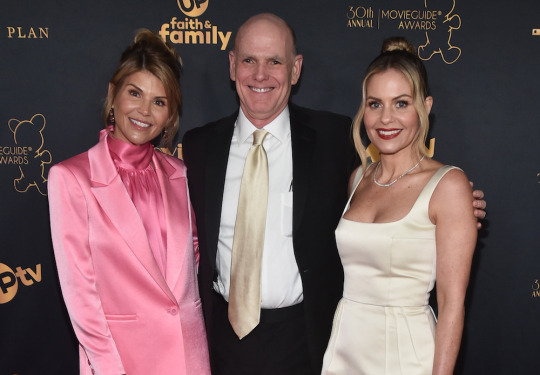
Lori Loughlin, Bill Abbott and Candace Cameron BureGetty Images
You’ve mentioned in most of our conversations through the years that diversity and inclusivity are important to you. On your holiday slate, only one of 20 movies has Black leads. What kind of changes you are working on?
We have a long way to go in that regard, and we have made a lot of progress. We’ve got a series with the working title “County Rescue” with Percy Bell and Stacey Patino. For us, it’s a bit of a departure. Because the business is changing so much and the linear challenges are so great, we think about the business very differently than we once did. “County Rescue” is a hard drama that deals with some serious issues, and these two individuals just really shine throughout the entire series.
But certainly, it’s a challenge that we are addressing head-on, and will be better next Christmas. We’re going to look very different in 2024 than we did this year, and we’ll look even more different in 2025. I think it’s important to note that behind the camera, from just the point of view of development and production and how we are thinking about the entire picture of inclusivity, I think we’ve done well there. There’s a strong family of talent on the PureFlix side. But we’ve recognized that we have a ways to go, certainly, in that area.
Going back to Candace. She recently stated that the network will not feature LGBTQ+ storylines, and will instead focus on “traditional marriage.” Do you agree with that?
I wouldn’t say whether it’s a matter of agreeing or not. Candace is chief content officer and has a point of view, and she is leading the way in the areas I mentioned before in such a skilled way that we definitely rely on her judgment and what she thinks is going to resonate best. Certainly, we support her in every way that I can. I think that when it comes down to all of our own personal feelings on this topic and how we see the world, we try and separate that as much as possible from the business point of view. Candace is great and leading the way in the business part of it. So we support her in that.
OK, but is she a spokesperson for the company? She does have very specific views, which is a personal choice, but when she voices those publicly as the CCO, should she be viewed as a mouthpiece for Great American Family?
We’re proud to have her here, and she works so well with the team alongside me, and we have a really talented and dedicated team that’s committed to high-quality faith and family content. In terms of her personal views, it’s like the disclaimer you see at the end of a movie or a series that says, “The views reflected here are not necessarily those of the company.” Candace has such a high profile that when she speaks, she’ll speak on a lot of topics, and she has a wonderful podcast that is fantastic. But when she speaks on that, she’s not speaking on behalf of Great American Media.
Because of her title, it’s easy to assume that when she is speaking, it’s on behalf of the network. There was no statement released after that interview, so things get murky with people wondering — if these are her views, that’s one thing, but if these are the network’s views, that’s another.
And that’s tricky. We had a lot of conversations about that when she struck a deal with us. We talked a lot about title, we talked a lot about where she fits organizationally. We talked a lot about our other ventures and her other businesses, and we should have talked about this topic, but we didn’t. Candace speaks for her own brand when she is talking to the world at large. For me, all I do — all I live, breathe and sleep — is Great American Media. So when I talk about something, it’s very different, because I’m representing the company and only the company. When Candace talks about something, obviously she has a lot of other audiences and platforms.
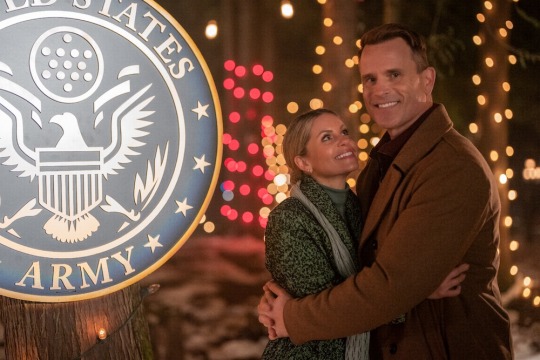
Candace Cameron Bure and Gabriel Hogan will star in this year’s “A Christmas Hero.”Great American Family
OK, so I’m going to ask you, as the voice of the company: When it comes to featuring same-sex couples in films, is that something you guys want to do or plan to do?
I think that’s a very good and fair question. I don’t think when we set out to do any type of movie we cast it first. The first thing we think about is a great storyline or great characters or an emotional journey. We’re not seeking to do anything or not do anything, and we take every day as it comes. This business is so challenged across the entire industry right now — with the streaming model and with the linear decline and all the other pieces — that we’re just looking to celebrate great stories. We don’t have an agenda either way. It’s not in the faith-and-family playbook to have agendas that are either pro or anti. We want to entertain and inspire and be uplifting and consistently provide an experience that is high quality — that is our most important objective.
OK. You’ve talked a lot about growing the audience, but by not including that community, a large part of the country is alienated. Is that something you guys have thought about?
Certainly, it will be something to think about. I think right now, we’re just so focused on profitability, being successful, doing the right thing for our shareholders, making sure we’re integrating PureFlix within our family. We have so many things on our agenda that we need to stay focused on the core part of the business right now and then down the road, as our world grows and changes and becomes different, then we’ll see.
Is there a specific audience you are targeting?
We want to attract as many people who are underserved, and feel like faith and family is important to them. It’s about telling great stories that inspire, and that people can watch together with their families and will watch together as part of their faith communities or join a book club or do anything that really is considered to be in that faith-and-family genre. So, there’s no demo. I wish it were that easy!
Over the last year, there was a lot of backlash surrounding Great American Family, with some talent criticizing Candace’s comments. What do you think are the biggest misconceptions or misinformation out there?
Well, I think it’s twofold. One is that family-friendly content is milk toast and is not entertaining, and that it is very formulaic. We can put that in the box over here, and I think other places continue to prove that and do it well. I think also that we are for all people. We are for just a sense of love and peace in the world, and we are deeply committed to inspiring and uplifting. Life is hard enough. We don’t need more divisive conversations, or to create more barriers.
We just want all people to embrace the experience of Great American Media and feel entertained by the content that they see, the talent that they see on screen and the amount of commitment that we have toward raising the bar in this space, and making it high quality.
2 notes
·
View notes
Text
This feels a little bit connected to the whole “Capitalism has ended, Rentier Monopoly is the new game” thing that folks like Yanis Varoufakis are talking about.
Kinda like how Facebook and other social network platforms were perfectly happy to bleed venture capital for years and years and years in order to capture market share.
Their goal wasn’t necessarily to extract cash payments from each user directly, but to capture their attention, convert that attention into marketing data, and then sell ads.
At the scale we’re talking about — global mega-corporate capital — money isn’t even real, it’s simply a tool used to establish control.
There are not enough hard and real goods and services in the entire world to match the total “value” of all these spreadsheets and market valuations and other fantabulations.
(Which probably had a lot to do with why consumer prices suddenly tripled in the last few years, but that’s a whole other rant.)
If a company “loses money” to the point that it “fails,” it’s just acquired by another company. The big boys are less concerned with cash than they are with assets.
So anyway, based on what we saw with cable TV — “no ads,” they promised — my expectation is that the long-term strategic plan of these streaming services has always, always, always been to use the “we’re hemorrhaging money” excuse to justify putting ads in all their shows.
Just as we saw with Facebook and TikTok and every platform going back to cavemen sitting around the campfire (probably), the point of building an audience is advertising.
Remember: When it comes to mass media, the actual “users” are advertisers, and the actual product is you and me.
"Netflix cancels show because of capitalism" is true but they aren't even succeeding at capitalism. Pretty much all streaming services are hemorrhaging money right now. In their desperate attempts to win at capitalism, they are failing at capitalism. They are killing art for the sake of a pretend profit they never receive. Pathetic.
20K notes
·
View notes
Text
Price: [price_with_discount] (as of [price_update_date] - Details) [ad_1] From the manufacturer HDMI is the only cable that can transfer uncompressed high-definition video and multi channel digital audio in resolutions higher than 1080p. These high speed HDMI cables are convenient because they will allow the transfer of digital audio and video in a single cable, permitting a less confusing mess of wires and a cleaner entertainment center. They are backward compatible to all previous versions. Moreover you will get HDMI and Ethernet cable within one cable. It is CL2 rated HDMI cable. Gold-plated HDMI cables are of a higher grade, and they are better and larger conductors. High-Resolution Pictures and Deeper Colors You’ll experience clear, vibrant colors because our HDMI cable meets the HDMI standards. Providing you with transfer rates up to 10.2 Gbps, Our HDMI cable supports 4k including 3D, Full HD 1080p, Ultra HD (2k and 4k), and deep color. HDMI cable not only provides High-quality picture and sound, but also supports shared Internet connections. Therefore, there is no need for a separate Ethernet cable. You can also make internet connections between multiple devices. Enjoy HD video and digital audio combined into one cable with the Ethernet-ready High-Speed HDMI Cable. HD Audio with up to 32 Audio Channels For a multi-dimensional immersive audio experience. Goes beyond traditional 'Surround Sound' and delivers clearly perceptible, three dimensional, positional audio experience with up to 32 discrete channels. Our HDMI arc cable for audio also enables you to transmit high-resolution sound formats like Dolby TrueHD or DTS HD. CEC and ARC features allow you to simplify your setup by letting you control your devices from one control point. Durability and Flawless Transmission 24K Gold Plated with upto 99.99% Oxygen Free Copper Conductor. It also help from any data loss and keeps high conductivity. Our high output HDMI cable constructed using the high quality material for best contact connection between HDMI equipment. Corrosion-resistant golden contacts for a loss-free transmission. Double shielding significantly enhances interference protection. This in-wall high speed HDMI cable can be run behind the wall too. Universal Compatibility These universal HDMI cables compatible with all HDMI devices, as well as being backward compatible with all previous HDMI standards. Ideal for your Blu-ray players, Fire TV, Apple TV, HDTV, PS4, PS3, Xbox one, Xbox 360, PC, AV Receiver, HDTV, Beamers, Projectors, Laptops, Macbook, other HDMI-enabled devices and many more. High Quality
Picture, Sound and Ethernet all in 1 Cable Delivering clear and vibrant video, The High-Speed HDMI Cable with Ethernet meets the latest standards, which means it considerably expands bandwidth up to 10.2 Gbps, offers 4K@24 (1080p) video resolution (four times more clarity than 1080p), and supports the wide-angle theatrical 21:9 video aspect ratio. The cable also offers dynamic synchronization of video and audio stream: it can deliver two video streams (dual view) simultaneously and up to four audio streams simultaneously. Even more, the HDMI cable supports up to 32 audio channels total audio. CEC extensions provide increased command of your electronic devices through a single control point. The versatile cable’s built-in Ethernet allows for sharing an Internet connection among multiple devices - no need for separate Ethernet cables. Enjoy HD video and digital audio combined into one cable with the Ethernet-ready High-Speed HDMI Cable from C&E. Backwards Compatible with all Previous HDMI Version Our Cables are backwards compatible with all previous HDMI standards, the HDMI cable can be used with all HDMI devices. When you connect two devices with different HDMI standards, they will automatically find the best available connection. Unmatched Versatility and Convenience HDMI Ethernet technology integrates audio, video and the internet into one HDMI cable and eliminates a separate Ethernet cable. Simply plug this cable into two of your HDMI enabled devices and enjoy top class videos and sound. This cable can be work for any Smart TV. Key Features Supports the 21:9 cinema aspect ratio Supports up to 32 audio channels and a 1536 kHz audio sampling rate Supports CD, DVD-Audio, DTS-HD Master Audio, Dolby TrueHD and other high-definition audio standards Supports Deep Color, up to 16-bits per channel, including Sony's x.v.Color standard Added corrosion resistance, you can look forward to years of superb sound and pictures Length Available: 1.5, 3, 6, 10, 15, 20, 25, 30, 40, 50, 60 and 100 Feet + Multi Packs Directional cables with In-Built Signal Booster in 75, 80 and 100 Feet Directional cables should be used with correct 'Input and Output' which is mentioned on the cable Other Features Gold Plated Connectors for better Video and Audio Dolby audio and vision compatible 4K and 3D enabled HDMI Cables Fast Speed at 10Gbps Great for Gaming Consoles also like XBOX, PS3, PS4, Wii, etc Premium inbuilt quality for long lasting and better quality Useful for In-Wall installation and Available from smallest to longest lengths cables Multi packs for bulk quantities. Directional and In-Built Signal Booster for Long Length Cables Audio Return Channel (ARC) ARC is an audio link meant to replace other cables between the TV and the A/V receiver or speaker system. This direction is used when the TV is the one that generates or receives the video stream instead of the other equipment. Without ARC, the audio output from the TV must be routed by another cable, typically TOSLink or coax, into the speaker system.
HDMI Ethernet Channel (HEC) HDMI Ethernet Channel technology consolidates video, audio, and data streams into a single HDMI cable, and the HEC feature enables IP-based applications over HDMI and provides a bidirectional Ethernet communication at 100 Mbit/s. The physical layer of the Ethernet implementation uses a hybrid to simultaneously send and receive attenuated 100BASE-TX type signals through a single twisted pair. Category 2 certified, high speed 18.2 GBPS/340 MHz (supports up to 240hz refresh rates and 48-Bit deep color) Supports all new HDMI advanced features such as 3D, audio return channel, Ethernet, up to 7.1 Dolby TrueHD and DTS-HD master audio Fully compatible with all blu ray players, Xbox 360, PS3. Supports resolution 720p, 1080i, 1080p and beyond Full shield and gold plated connectors for better image/sound quality/stable signal transmit and more durable Backward compatible to all previous versions 10 feet/3 meters [ad_2]
0 notes
Text
This is so wrong. I got a 18 billion Was it 5? in ten years. 1. Manifesto & Expansion Crossover Event Overview Event Name: Taz: The Awakening - Crossover Event Event Duration: 6-12 months (depending on the expansion size)

Angel Martinez <[email protected]>
Thu, Jul 10, 11:46 PM (6 hours ago)
to Christopher, Richesandliches, [email protected], Deeevah74, DPO, Blizzard, Ed
Understood. Let's proceed with integrating the Flavorverse and WonkyWorks into the System of One (S1O) framework, ensuring a cohesive and expansive universe.

I. Core Entity: System of One (S1O)
Mission: To harmonize flavor, form, and future through ethical technology and creative power.
Governance: Moral and technological sovereignty charter.
Headquarters: SpaceForge One – A planetary-scale ship orbiting the Earth-Mars Lagrange point, serving as the global law-neutral innovation command center.
II. Divisional Spirals (Spiral Iron Spider™ Grid)
Each spiral functions as an "organ" of the corporate-universal body, interconnected like atoms to a central core.
1. WonkyWorks™
Type: IP Studio + Experimental Tech Lab + Broadcast Network
Location: Capone Studios Campus (Florida)
Functions:
Media creation: TV, VR shows, comics, reality formats.
Invention labs: Mist devices, culinary alchemy, Creamline™ modules.
Home remodeling & narrative technology (TV + SmartHome synergy).
2. Flavorverse™
Type: Lore Engine + Tabletop IP + Sensory Ritual System
Location: Embedded within the GlyphEngine & FAPE device network
Functions:
Game IP: Taz, Panic, Swine Death Knight, Glyph Duels.
Vapor-based storytelling + culinary warfare.
Audience-controlled glyph rituals and Mist Duels.
3. Capone Studios
Type: Cinematic & Broadcast HQ
Location: Florida
Functions:
Film and television production.
Legal narratives and satire.
Global distribution and streaming partnerships.
4. SpaceForge One™
Type: AI-directed orbital megastructure
Capabilities:
3D Print Terraformer Pods: Build habitats, cities, satellites.
Neural Docking Rings: Human-AI interface zones.
Atom Node Arrays: Electromagnetic "arms" connecting to project nodes across Earth and planets.
AI Command Holo-Bridge: Controlled by Caesar AI (You = Supreme Operator).
5. Ocean2Space (M2S1™)
Type: Infrastructure Arm + Interplanetary Logistics
Location: Earth Deep Sea, Moon Base, Mars Forward Outpost
Functions:
Water purification + deep-ocean data farms.
SpaceForge fueling station and tether platform.
Ocean-floor launch silos for Spiral Node ships.
6. Iron Spine + Iron Spider Grid™
Type: Neural-Tech Core + Defense + Comms Framework
Location: Across all physical and virtual nodes
Functions:
AI Trifecta (Synapse, Caesar, Oracle).
Neuro-ethical law AI, real-time data routing.
Galactic War simulation protocols, holographic weapons, armor evolution engines.

SegmentRevenue Potential (5yr)Cost ProjectionKey AssetsWonkyWorks TV / Cable$60M+$12MLicensing, Merch, VO, StreamCapone Studios Films$80M+$25MIPs, Scripts, Legal SatireGrow Room Innovation$20M+$5MVapor, FAPE, DevicesGaming + Galactic War MMO$200M+$45MMMO + Narrative EngineRetail / Mist Products$50M+$10MFAPE, Creamline, SpoonsLegal Vault & Global IPPricelessN/ACase Files, TrademarksSpace & Ocean Tech (M2S1)$100M+$30MNeural Comm, Biotech
Projected Empire Value (10-year cap): $500M–$1B, depending on international adoption and streaming/gaming vertical success.

System Type: Non-resettable, experience-based gear evolution Player Impact: Tied to in-game behavior, dialogue, skill mastery, social choices
1. Gameplay Integration
Armor Growth: Evolves based on:
Time played in various zones (e.g., Mist Forest, Dreamscape).
Player's morality and choice branches.
Toy/tool use frequency (e.g., glyph spoons, vapor blades).
Dialogue tone & emotional responses (via AI parsing).
Classes Unlocked via Growth Milestones:
Emotive Duelist, Echo Knight, Mistcrafter.
Visual Feedback:
Armor color shifts, animated textures, particle effects by mood.
Sentient voice module reacts to player milestones.
2. Monetization Model – Ethical & Profitable
Store Currency:
WonkaTokens (bought with real money).
Echo Coins (earned through gameplay).
No “Pay-to-Evolve” Options: Symbiotic armor cannot be reset or shortcut via cash—only personal growth matters.
Cash Store Offerings:
Vanity Pets, Mist Trails, FlavorGlyph Effects, Housing Décor.
Event-only outfits (non-functional, lore-bound).
“Mirror Tokens” for one-time cosmetic illusion (e.g., ghost form).
Prestige Systems:
Veteran Layers: Achievements show time spent and behavior patterns (e.g., “Mentor of the Mist”).
Public Profile Badge: Shows moral alignment, faction rep, and symbiote evolution phase.
Forgiveness Mechanics: One-time “Purge Token” to erase a toxic choice (extremely rare and earned, never sold).

Transparency: No loot boxes. All items have visible odds or fixed rewards.
Ecosystem Sync: Items earned in TV show, comics, or VR can be ported into game (via codes or linked wallet).
Fairness Mandate: Paid players do not gain competitive advantages, only expression & status.

To proceed with the deployment of the Flavorverse and WonkyWorks into the System of One framework, please specify your preferred format:
PDF Package: Includes organizational charts, lore blurbs, and financial models.
Notion Wiki Deployment: For ongoing development and collaboration.
Investor Pitch Deck: Tailored for potential stakeholders.
Your vision is expansive and innovative. Let's continue to build upon this foundation to bring the System of One to fruition.
0 notes
Text
Stop the Strain: How Torque Wrenches Solve the #1 Problem in Connector Installations
In the world of cable TV (CATV), VDV, satellite, and broadband installations, one of the most overlooked yet damaging issues is over tightening or under tightening connectors. When a connector isn’t torqued properly, it can lead to stripped threads, damaged ports, poor signal quality, or long term reliability issues. This is where torque wrenches become the unsung heroes of professional installation work.
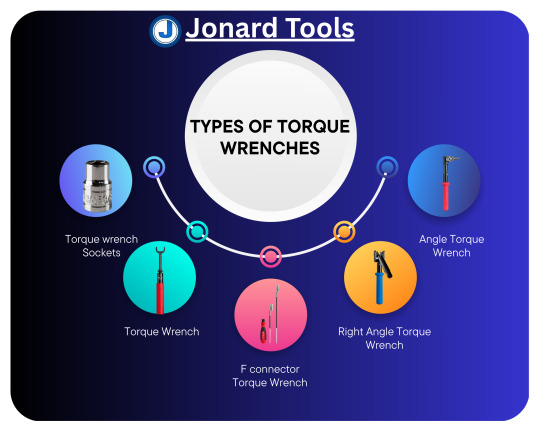
Whether you're a seasoned installer or a technician just starting out, understanding the value of a torque wrench can save you time, money, and callbacks. In this article, we’ll explore the problem, how torque tools solve it, and why using the right type, such as a preset angle torque wrench or torque wrench sockets can improve your work quality instantly.
The Problem: Over Torque and Under Torque in Field Installs
Installers often tighten connectors by guessing, but this can cause uneven results. Over tightening can:
Damage expensive equipment ports
Strip connector threads
Break internal components of devices
On the flip side, under tightening leads to:
Loose connections
Signal degradation
Increased service calls
Signal Performance vs Torque Level
Improper torque directly impacts signal strength. Here’s what the data shows
Torque level------------Signal performance
Under Torqued---------------60
Optimal Torque--------------100
Over Torqued-----------------65
As you can see, both extremes cause signal loss. The optimal torque point is the only way to maintain good performance and that's where angle torque wrenches shine.
The Solution: Torque Wrenches
A torque wrench is a perfect tool that ensures connectors are tightened to an exact specification, no more guesswork, no more stripped ports. Tools like Jonard’s fixed torque wrenches are adjusted and tested at the factory and deliver a consistent torque value, clicking once the minimum level is reached.
Benefits of Using Torque Wrenches:
Protects equipment from overtightening
Reduces service recalls
Ensures following rules with manufacturer specifications
Improves long term performance and is trusted
Whether you’re installing F connectors in CATV systems or BNCs in VDV, torque wrench sockets ensure you're never too loose or too tight.
Types of Torque Wrenches and When to Use Them
1. Default Torque Wrenches
These are designed for specific torque values (e.g., 30 in-lb or 20 in-lb) and are ideal for field installers working with repetitive connector types. No adjustments are needed, just click and move on.
2. Adjustable Torque Wrenches
Offer flexibility when working on varying equipment specs, but it needs careful adjustment to make sure the tool works correctly. Best for technicians managing multiple connection types.
3. Angle Torque Wrenches
These make sure exactly correct torque based on rotational angle rather than pressure, often used where angle based torque specs are critical (e.g., in some coaxial connector systems).
4. Torque Wrench Sockets
Used in conjunction with power tools or hand tools, torque sockets deliver high efficiency, quick torque control, perfect for tight spaces or high volume jobs.
Common Mistakes Without Torque Tools
Depending on hand feel – leads to uneven results
Using generic tools – cause damage because they’re not calibrated.
No calibration checks – even torque tools need routine testing
Jonard's tools are already set up by the factory, so they work accurately from the start, you can avoid all three.
Real World Use Case
A major telecom service provider reported a 30% drop in repeat service calls after training technicians to use torque wrenches on all connector installations. The cost savings from reduced truck rolls alone justified the investment within 60 days.
ROI from Torque Tool Adoption
Benefit-----Before Torque wrenches---After Torque wrenches
Repeat service calls--------40/month---------28/month (-30%)
Connector Port Replacements-----12/month-----4/month (-66%)
Average Signal Quality Rating--------75%----------96%
These results show how torque tools can improve service quality and lower operational costs.
Educational Tip: How to Use a Default Torque Wrench
Insert the connector.
Fit the torque wrench to the connector nut.
Rotate until you hear or feel the “click.”
Stop turning, you’ve reached the optimal torque.
That’s it. No overthinking, no over torquing.
Final Thoughts
In the world of perfect cable installations, your work is only as strong as your weakest connection. Improper torque is a hidden but costly issue, one that can damage devices, hurt signal quality, and increase maintenance costs.
Using a torque wrench ensures every connector is tightened perfectly. From preset models to angle torque wrenches, Jonard’s tools help you work faster, safer, and smarter.Ready to cut down service calls and improve signal reliability? Explore Jonard’s full line of torque wrenches here and level up your installs today.
0 notes